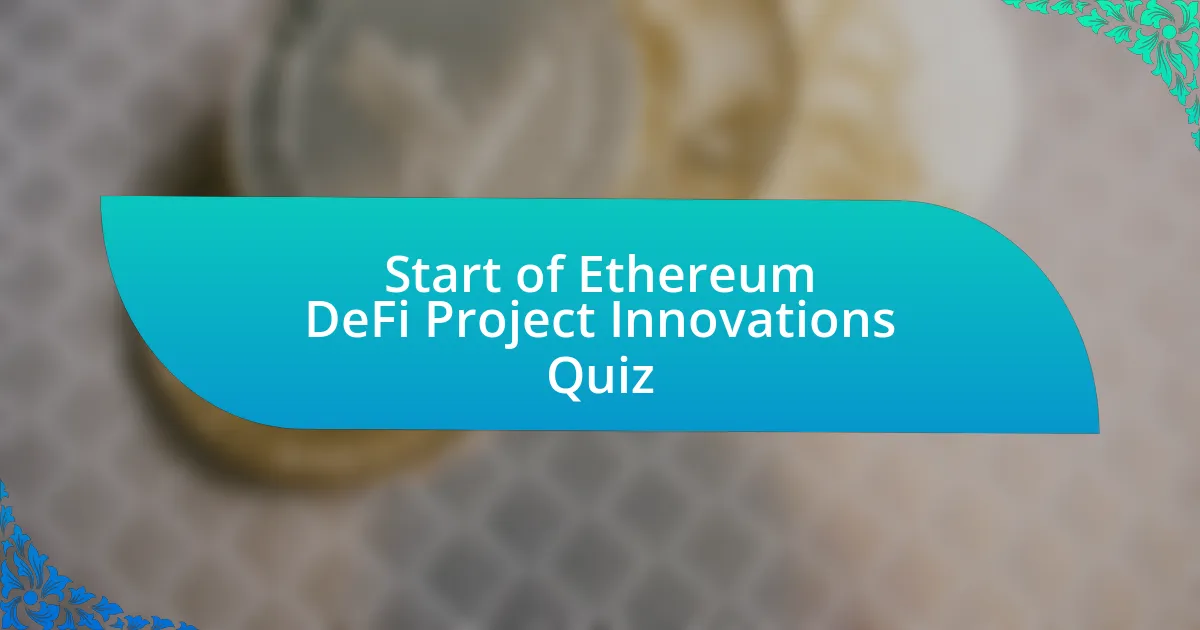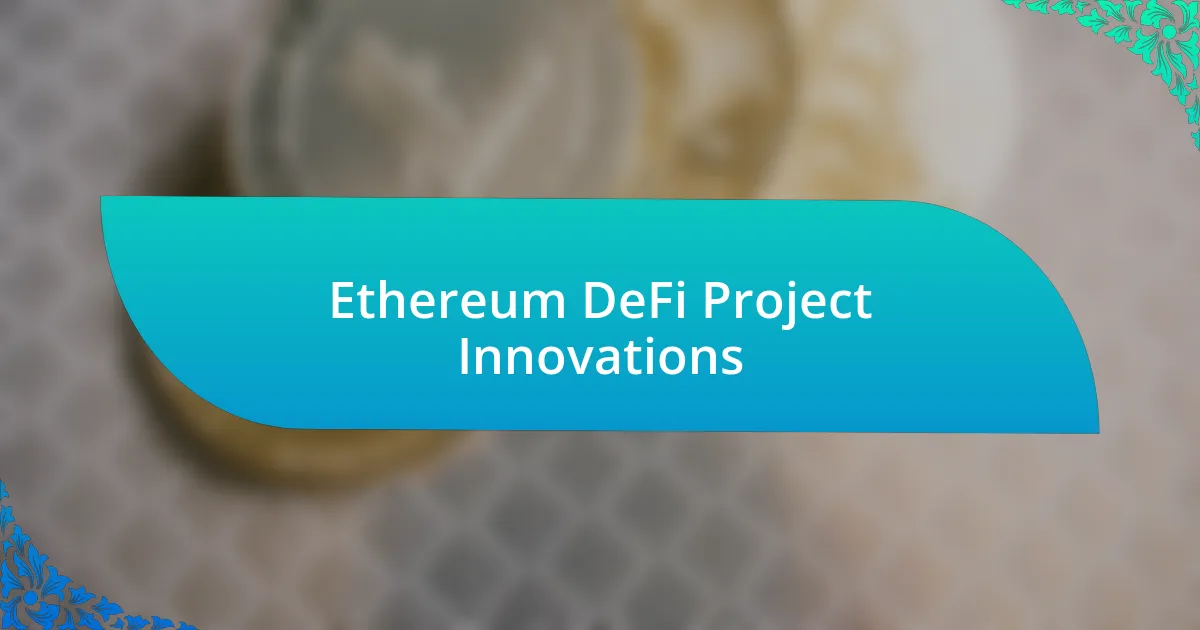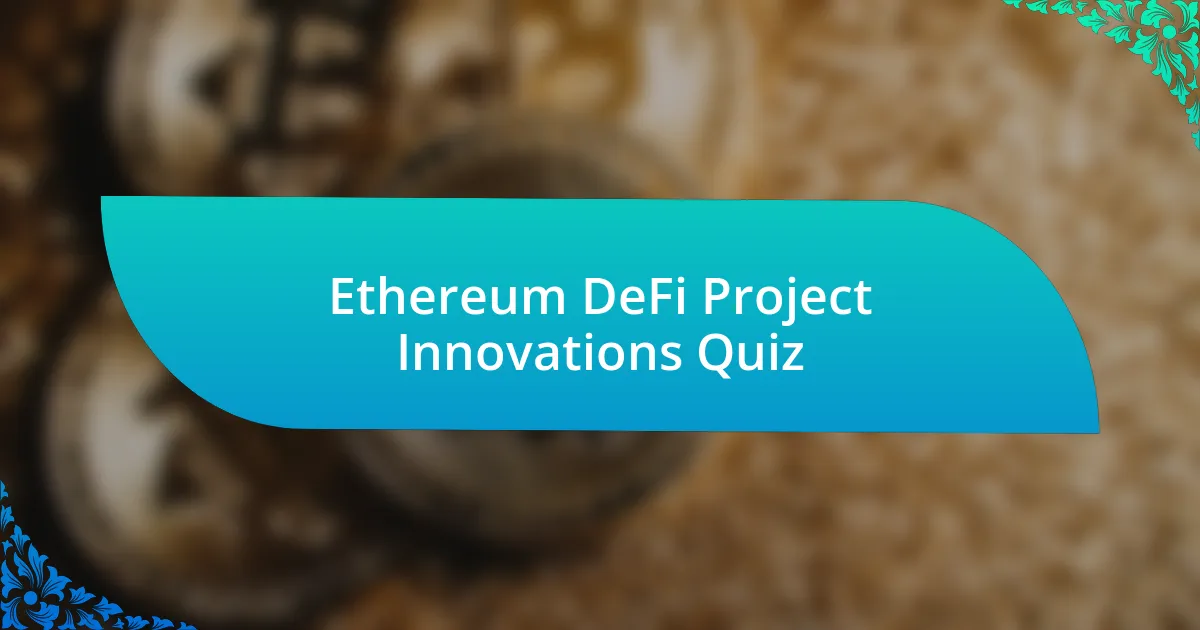
Start of Ethereum DeFi Project Innovations Quiz
1. What is the primary blockchain platform for most DeFi projects?
- Cardano
- Ethereum
- Solana
- Binance Smart Chain
2. What is the foundation of DeFi projects?
- Paper contracts.
- Centralized databases.
- Traditional banking systems.
- Ethereum’s smart contract functionality.
3. Which DeFi projects are powered by Ethereum?
- Aave, Uniswap, and Synthetix.
- Bitcoin, Ripple, and Cardano.
- Solana, Polkadot, and Litecoin.
- Chainlink, Dogecoin, and Stellar.
4. What challenges do Ethereum DeFi projects face?
- Lack of user-friendly interfaces.
- Overregulation of cryptocurrency markets.
- Limited networking opportunities.
- Scalability and high gas fees.
5. What solutions aim to address scalability and high gas fees in Ethereum DeFi?
- Multi-signature wallets, yield farming, and liquidity pools.
- Non-fungible tokens, token swaps, and stablecoins.
- Ethereum 2.0, sharding, and Layer 2 networks.
- Blockchain forks, centralized exchanges, and hard wallets.
6. How does Ethereum contribute to DeFi innovation?
- Ethereum functions solely as a traditional banking platform without any innovative features.
- Ethereum’s rigid structure limits the development of diverse financial applications.
- Ethereum exclusively supports only a single type of financial product without variation.
- Ethereum’s flexibility allows developers to create a wide array of decentralized applications (dApps) that perform financial functions without needing a centralized authority.
7. What is the role of smart contracts in DeFi?
- Smart contracts eliminate all forms of transaction fees entirely.
- Smart contracts enable automated, transparent, and trustless transactions.
- Smart contracts offer measurable investment returns directly.
- Smart contracts require intermediaries for every transaction.
8. What are some significant use cases for Ethereum in DeFi?
- Decentralized lending and borrowing platforms like Aave and Compound.
- Centralized exchanges for trading cryptocurrencies.
- Only token minting and burning processes on Ethereum.
- Traditional banking systems integrating blockchain solutions.
9. How do decentralized lending and borrowing platforms work?
- These platforms charge high fees and do not allow for collateral or interest rate agreements.
- These platforms require users to send their crypto assets to a centralized authority for processing their transactions.
- These platforms allow users to lend their crypto assets to others in exchange for interest or borrow assets by providing collateral, all governed by smart contracts.
- These platforms involve manual processing and do not utilize any blockchain technology for transactions.
10. What is the future of Ethereum in DeFi?
- The future includes improvements in security, scalability, and the rise of more complex financial products.
- The future depends solely on Bitcoin’s performance and adoption rates.
- The future will focus exclusively on non-blockchain banking solutions.
- The future will see Ethereum completely replaced by other cryptocurrencies.
11. What are Layer 2 solutions for Ethereum?
- Layer 2 solutions like Optimism and Arbitrum provide faster and cheaper transaction processing on secondary blockchains that connect back to the main Ethereum network for security.
- Layer 2 solutions like Ripple and Stellar act as independent currencies with no connection to Ethereum`s functionality.
- Layer 2 solutions like Solana and Cardano are exclusive options that replace Ethereum entirely with different blockchains.
- Layer 2 solutions like Bitcoin and Litecoin enhance Ethereum through mining exchanges and asset liquidity.
12. What is the purpose of interoperability bridges in DeFi?
- Interoperability bridges enhance social media interactions within decentralized applications.
- Interoperability bridges provide access to centralized exchanges for users to trade easily.
- Interoperability bridges secure user wallets with advanced encryption methods for safe transactions.
- Interoperability bridges allow users to transfer crypto assets (tokens and NFTs) across blockchains, creating a more interconnected DeFi ecosystem.
13. What are DID projects in the context of DeFi?
- DID projects aim to empower users with control over their digital identities.
- DID projects are exclusive to specific blockchain platforms.
- DID projects focus on anonymous transactions without identity verification.
- DID projects offer centralized identity management solutions for users.
14. What are on-chain options and derivatives in DeFi?
- On-chain options and derivatives involve exclusively fiat currency transactions on decentralized platforms.
- On-chain options and derivatives refer to traditional finance contracts moved to centralized exchanges.
- On-chain options and derivatives are primarily used for trading physical assets in DeFi ecosystems.
- On-chain options and derivatives bring speculative contracts onto the blockchain, enhancing transparency and potentially improving security.
15. How do real-world asset integrations impact DeFi?
- Integrating real-world assets creates barriers to entry for new users.
- Integrating real-world assets enhances liquidity and opens innovative use cases in DeFi.
- Integrating real-world assets limits access to only crypto investors.
- Integrating real-world assets reduces transaction speed and increases costs.
16. What is the main difference between Bitcoin and Ethereum blockchains?
- Bitcoin has smart contracts similar to Ethereum`s capabilities.
- Bitcoin processes transactions faster than Ethereum due to its simpler structure.
- Bitcoin is a first-generation blockchain technology focusing on digital currency, while Ethereum introduces smart contracts and decentralized applications.
- Bitcoin is used primarily for decentralized finance projects, replacing Ethereum`s role.
17. What is the Ethereum Virtual Machine (EVM)?
- The Ethereum Virtual Machine (EVM) is a centralized server managing transactions on Ethereum.
- The Ethereum Virtual Machine (EVM) is a physical computer running Ethereum applications.
- The Ethereum Virtual Machine (EVM) is a decentralized virtual machine capable of handling scripts using the public nodes network, and it is Turing complete.
- The Ethereum Virtual Machine (EVM) is a hardware wallet for Ethereum storage.
18. What is the value token for Ethereum?
- Litecoin (LTC)
- Ripple (XRP)
- Bitcoin (BTC)
- Ether (ETH)
19. What is the smallest unit in the Ether cryptocurrency?
- Gwei
- Wei
- Kwei
- Ether
20. How much Wei is in one Ether?
- 1 Ether = 10^21 Wei
- 1 Ether = 10^20 Wei
- 1 Ether = 10^18 Wei
- 1 Ether = 10^16 Wei
21. What is Proof-of-Work (PoW)?
- Proof-of-Work is a consensus algorithm that requires work from miners to validate transactions by solving complex computational problems using hardware.
- Proof-of-Work is a set of rules for decentralized governance in DeFi projects.
- Proof-of-Work is a protocol for sending instant transactions on the blockchain.
- Proof-of-Work is a type of cryptocurrency wallet used for storage.
22. What is the difference between Bitcoin and Ethereum in terms of transaction verification?
- Bitcoin verifies transactions through central authorities, while Ethereum relies on user confirmations.
- Bitcoin processes transactions at a fixed rate, while Ethereum operates at a varying speed depending on demand.
- Bitcoin checks unspent transaction outputs (UTXO), while Ethereum checks the latest state for the account balance.
- Bitcoin uses a different algorithm for block creation, whereas Ethereum uses a unique hashing method.
23. How do smart contracts work in real-world scenarios?
- Smart contracts can be used in real-world scenarios like real estate, where a seller can set up a smart contract to sell property, transferring ownership once the buyer transfers the property amount.
- Smart contracts only work in theoretical scenarios and cannot be applied in real-world transactions.
- Smart contracts are only applicable to online gaming platforms for automated payouts and rewards.
- Smart contracts can be used to program traditional banking services without any digital assets involved.
24. What is MetaMask?
- MetaMask is a mining software for Ethereum blockchain.
- MetaMask is a popular browser-based Ethereum wallet that can be used to interact with dApps on the Ethereum network.
- MetaMask is a decentralized exchange for trading cryptocurrencies.
- MetaMask is a hardware wallet for storing Bitcoin securely.
25. What is Truffle?
- Truffle is a type of chocolate dessert made with cream.
- Truffle is a brand of gourmet cooking oil used in fine dining.
- Truffle is a popular testing and development environment for Ethereum, offering an asset pipeline to handle Ethereum-based projects.
- Truffle is a rare species of wild mushroom found in forests.
26. What is the block time and average block size in Ethereum?
- The block time is 20 seconds, and the average block size is 500 KB.
- The block time is 14 seconds, and the average block size is 2 KB.
- The block time is 10 seconds, and the average block size is 1 MB.
- The block time is 30 seconds, and the average block size is 256 KB.
27. Can transactions be kept hidden on the Ethereum network?
- Yes, transactions can be fully hidden.
- Transactions can be encrypted for privacy.
- Only some transactions can be concealed.
- No, all transactions are public on the Ethereum network.
28. Is the user’s private key used to sign transactions?
- No, a random key is used to sign transactions.
- No, the user’s public key is used to sign transactions.
- Yes, the user’s wallet address is used to sign transactions.
- Yes, the user’s private key is used to sign transactions.
29. What is the purpose of Testnet in Ethereum?
- Testnet connects users to the main Ethereum market.
- Testnet is used for testing dApps without real Ether.
- Testnet is a wallet for storing Ether securely.
- Testnet is a platform for trading NFTs.
30. Do you need to use real Ether to test dApps and smart contracts?
- Yes, real Ether is mandatory for testing.
- Real Ether is only needed for mainnet launches.
- No, free Ether can be used in test networks.
- No, Ether can only be used for live dApps.

Congratulations! You’ve Successfully Completed the Quiz
Thank you for participating in our quiz on Ethereum DeFi Project Innovations. We hope you found the experience both informative and enjoyable. Quizzes like this not only test your knowledge but also help reinforce what you’ve learned about the ever-evolving world of decentralized finance. It’s a space that continues to introduce groundbreaking ideas and technologies, and your engagement is a step toward greater understanding.
Through this quiz, you may have discovered various innovative projects that are transforming finance as we know it. You learned about how DeFi leverages blockchain technology to create new opportunities for users worldwide. Understanding these concepts is essential as they are shaping the future of finance and enabling greater accessibility for everyone.
We invite you to continue your journey of learning by exploring the next section on this page. Here, you’ll find in-depth information on Ethereum DeFi Project Innovations that can further enhance your knowledge. Dive into the resources available and stay ahead in this exciting field!

Ethereum DeFi Project Innovations
Overview of Ethereum DeFi Innovations
Ethereum DeFi innovations encompass various financial services built on the Ethereum blockchain. These innovations facilitate decentralized exchanges, lending protocols, yield farming, and automated market makers. They eliminate intermediaries, enabling users to engage directly in peer-to-peer transactions. The Ethereum platform allows developers to create smart contracts that automate and secure these financial processes. This flexibility has led to rapid growth in the DeFi sector, significantly impacting the traditional financial landscape.
Key Features of Ethereum DeFi Projects
Key features of Ethereum DeFi projects include composability, transparency, and programmability. Composability allows different DeFi applications to interact seamlessly, creating new financial services. Transparency is inherent to blockchain technology, enabling users to audit transactions easily. Programmability via smart contracts permits developers to design custom financial solutions. These features enhance user trust and foster a vibrant, interconnected DeFi ecosystem.
Recent Innovations in Ethereum Lending Platforms
Recent innovations in Ethereum lending platforms introduce concepts like flash loans and collateral-backed loans. Flash loans enable users to borrow assets without upfront collateral, provided the loan is returned within the same transaction block. Collateral-backed loans require users to deposit assets as collateral, minimizing risk for lenders. Platforms are also adopting advanced algorithms to optimize interest rates, improving efficiency in lending markets.
Impact of Layer 2 Solutions on Ethereum DeFi
Layer 2 solutions significantly enhance Ethereum DeFi by improving scalability and reducing transaction costs. Solutions like Optimistic Rollups and zk-Rollups process transactions off the Ethereum main chain, alleviating congestion. This scalability allows for more users and higher transaction volumes without compromising speed. As a result, DeFi applications can operate more efficiently, encouraging wider adoption and usage.
Emerging Trends in Ethereum DeFi Governance Models
Emerging trends in Ethereum DeFi governance models focus on decentralized autonomous organizations (DAOs) and community-driven decision-making. DAOs enable token holders to participate in critical decisions about project development, resource allocation, and protocol upgrades. This shift fosters greater inclusivity and transparency, aligning the interests of the community with the project’s direction. As governance models evolve, they enhance user engagement and contribute to project sustainability.
What is Ethereum DeFi?
Ethereum DeFi, or decentralized finance, refers to a blockchain-based financial ecosystem built on the Ethereum network. It utilizes smart contracts to eliminate intermediaries in financial transactions. This includes services such as lending, borrowing, trading, and yield farming. DeFi aims to enhance financial accessibility and transparency, leveraging Ethereum’s programmability and security features for various financial applications.
How does Ethereum DeFi work?
Ethereum DeFi works by deploying decentralized applications (dApps) on the Ethereum blockchain. Users interact with these dApps through wallets without needing traditional financial institutions. Smart contracts automate transactions, ensuring they execute when predetermined conditions are met. This process enables peer-to-peer interactions for lending, trading, and other financial activities, making transactions faster and reducing costs typically associated with middlemen.
Where can I find Ethereum DeFi projects?
You can find Ethereum DeFi projects on several platforms, such as DeFi Pulse, which tracks various DeFi applications and their total value locked (TVL). Also, decentralized exchanges (DEXs) like Uniswap and lending platforms like Aave host many Ethereum-based DeFi projects. Their governance tokens are often available on platforms like CoinGecko or CoinMarketCap, providing insights into market trends and project details.
When did Ethereum DeFi gain popularity?
Ethereum DeFi gained significant popularity in mid-2020, during what is often referred to as the “DeFi summer.” Token incentives and liquidity mining attracted many users. Projects like Compound and Yearn.Finance significantly increased their user bases and total value locked. This surge was accompanied by a major rise in the overall cryptocurrency market, reflecting a growing interest in DeFi solutions.
Who are the key players in Ethereum DeFi?
Key players in Ethereum DeFi include projects like MakerDAO, which enables the creation of the DAI stablecoin, and Compound, a protocol for decentralized lending. Uniswap revolutionized decentralized trading with its automated market maker model. Other significant contributors include Aave for lending, Synthetix for derivatives trading, and Yearn.Finance for yield optimization. These projects are crucial in driving innovation within the DeFi ecosystem.

